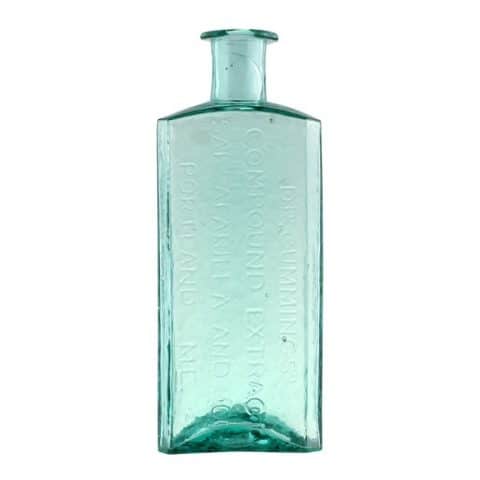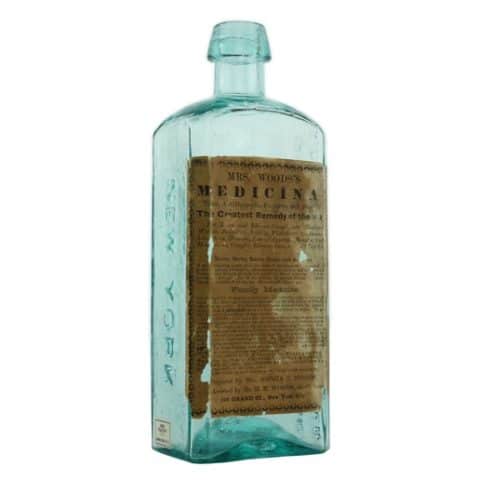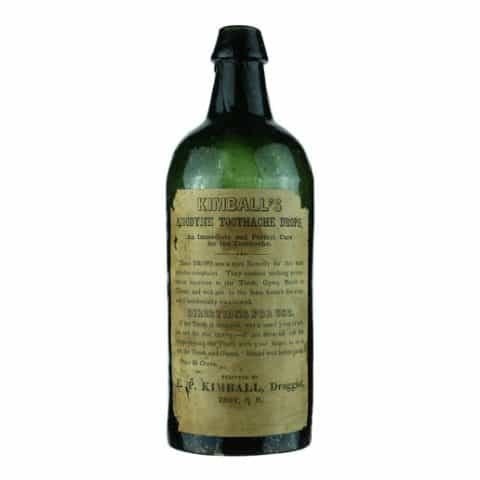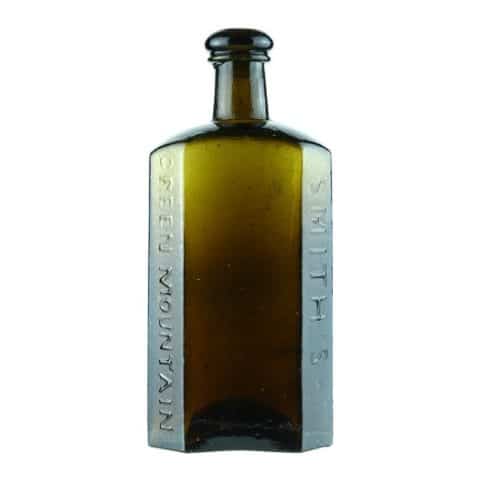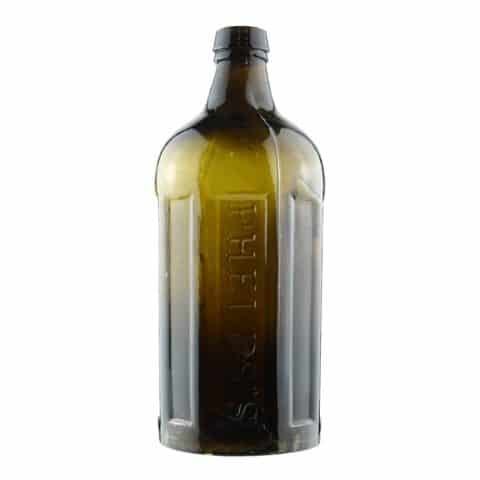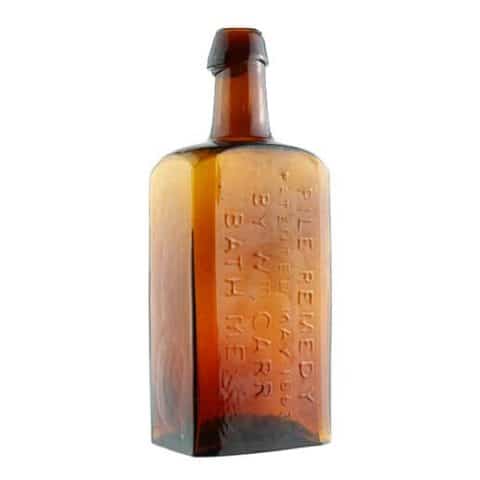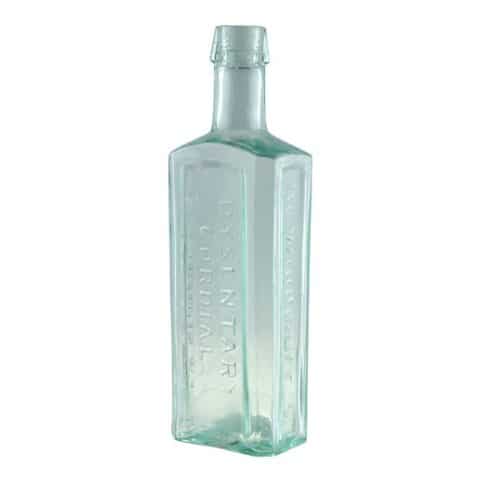Dr. Woodruff’s Dysentary Cordial Columbus Ga
Dr. Woodruff’s Dysentary Cordial
Columbus Ga
Dr. Michael Woodruff, Columbus, Georgia
Aquamarine Medicine
Provenance: Allen Woodall Collection

Scant information is available on Dr. M. Woodruff though we know he was born in New Jersey in 1810. He resided and was a life-long physician in Columbus, Georgia, until he died in 1870. His wife was Abigail T. Wells Woodruff, who he married in 1834 in Richmond, Georgia. Their children were Sophronia Farrington Dews, Margaret Ann Woodruff, Stephen Thomas Woodruff, Wilbur Fisk Woodruff, Anna Woodruff, Henry Wills Woodruff, Ella K. Banks, and Mary J. Willingham.
The first time we see a newspaper reference to Dr. Woodruff is April 1, 1843, when a notice is placed in the Macon Georgia Telegraph reading, “Dissolution. The Copartnership heretofore existing between Drs. Thompson & Woodruff was this day dissolved by mutual consent. Those persons indebted to the firm are requested to call and make immediate payment. – M. S. Thompson (and) M. Woodruff.
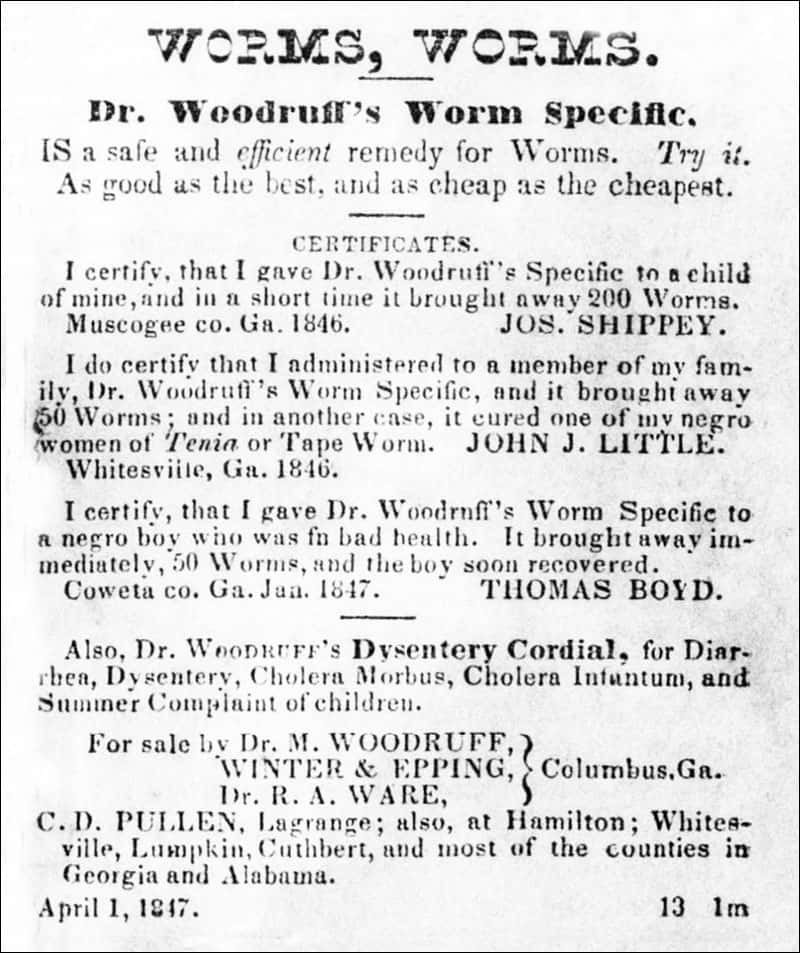
In the first half of 1844, up until December of that year, advertisements for “Drs. M. & W. Woodruff’s Laboratory” in Columbus, Georgia, appeared to promote his Dr. Woodruff’s Vegetable Family Medicines, which included Indian’s Golden Tonic Mixture, Dr. Woodruff’s Worm Specific, and Dr. Woodruff’s Dysentary (sic) Cordial. A year later, Dr. M. Woodruff’s operated from his Botanic Medicine Store on Broad Street in downtown Columbus. By then, Dr. Woodruff’s Dysentary (sic) Cordial For Diarrhoea (sic) was his breakout medicine for sale. It was for “Dysentary (sic). Bloody Fluk and Summer Complaint of Children.”

Other advertising said, “Is Dr. Woodruff’s Dysentery Cordial a Humbug? Those that can believe it to be, after reading the above, merely because an interested individual or individuals give it as their opinion we will advise not to try it less they might be imposed upon cheated out of their money and injured in their health.” – M. Woodruff M.D., July 15, 1846.

The aquamarine Dr. Woodruff’s Dysentery Cordial bottle is rectangular with beveled sides, 8 5/8 inches tall and extremely rare. The obverse side of the bottle has a flat, arched face and is where the proprietor would have placed a paper label. There are three arched, recessed, and chamfered vertical panels. The first thin side panel has embossed serifed copy, from shoulder to base, reading. ‘DR. WOODRUFF’S’ using a small, raised, and underscored “R” in “DR.” The reverse wide panel is embossed, reading ‘DYSENTARY CORDIAL’ in two centered lines. “Dysentary” should be spelled “Dysentery.” The last side panel is embossed. ‘COLUMBUS, GA.’ The “GA” uses a small, raised, and underscored “A.” The bottle has a tall neck set on a curved shoulder finished with a crude applied tapered collar. There is a blowpipe pontil scar.

Some years ago, Jack Klotz, in Hannibal, Missouri, dug a 7 ¼ inch tall variant, “Dr. Woodruff’s Dysentery Cordial,” where all embossed copy occurred on an inset panel in three lines with no other embossing. A third variant is known and is similar to the second.This bottle measures 7 ¼” inches tall. Jack said the first Dr. Woodruff bottle he became aware of came from a privy in Old Williamsburg, Virginia, and was in a report files by a local archeologist. A shorter “Dr. Woodruff’s Worm Specific” bottle is known and is 5 1/8 inches tall. The copy occurs occurs on the two wide panels. All four Dr. Woodruff bottles are on display at the Columbus Collective Museums.

The 1850 United Stated Federal Census noted that M. W. Woodruff was a physician with ten enslaved living in Columbus, Georgia. By 1860, the census said his post office was Columbus, and his occupation was a physician. He was doing quite well as his real estate value was $16,000, and his estate value was $15,000. Michael Woodruff would die in 1860 of Dyspepsia.
The Woodruff name is connected to the legacy of Coca-Cola, which was invented in Columbus and first sold in Atlanta by John Pemberton. In 1919, Ernest Woodruff led a group of investors in purchasing the Coca-Cola Company from Asa Candler. In 1923, he asked his son, Robert, to lead the company. Robert W. Woodruff was president from 1923 until 1954, remaining on the Board of Directors until 1984.

Columbus, Georgia
Columbus, named for Christopher Columbus, was founded in 1828 by an act of the Georgia Legislature and was located on a bluff at the beginning of the navigable portion of the Chattahoochee River. The river served as the city’s connection to the world, enabling it to ship its commodity cotton crops from the plantations to the international cotton market via New Orleans and, ultimately, Liverpool, England. The city’s commercial importance increased in the 1850s with the arrival of the railroad. In addition, textile mills were developed along the river, bringing industry to an area reliant upon agriculture. By 1860, the city was one of the more important industrial centers of the South, earning it the nickname “the Lowell of the South,” referring to an important textile mill town in Massachusetts. The city would also become one of the Confederacy’s most important industrial centers. The Battle of Columbus, Georgia, on Easter Sunday, April 16, 1865, was the last Civil War battle that occurred after General Lee’s surrender to Grant and the assassination of Abraham Lincoln.
Primary Image: Dr. Woodruff’s Dysentary (sic) Cordial bottle imaged on location by Alan DeMaison, FOHBC Virtual Museum Midwest Studio.
Support Image: Variant Dr. Woodruff’s Dysentery Cordial in a grouping of dug bottles from the Jack Klotz collection.
Support Image: Four Dr. Woodruff bottles. The lowest example is the museum example. – Allen Woodall, Columbus Collective Museums
Join the FOHBC: The Virtual Museum is a project of the Federation of Historical Bottle Collectors (FOHBC). To become a member.










